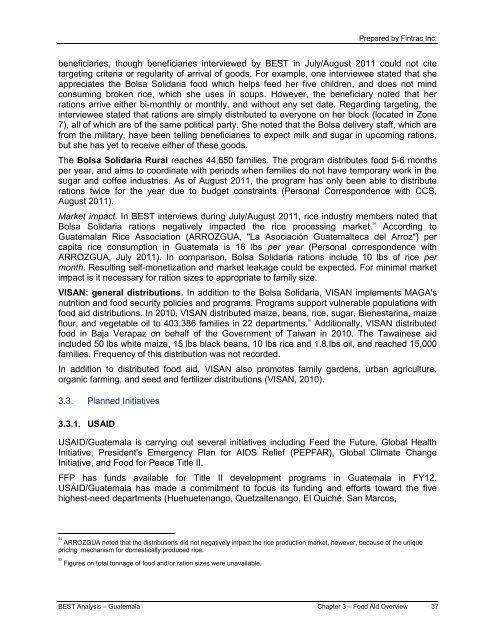usaid office of food for peace guatemala bellmon estimation
usaid office of food for peace guatemala bellmon estimation
usaid office of food for peace guatemala bellmon estimation
You also want an ePaper? Increase the reach of your titles
YUMPU automatically turns print PDFs into web optimized ePapers that Google loves.
Prepared by Fintrac Inc.<br />
beneficiaries, though beneficiaries interviewed by BEST in July/August 2011 could not cite<br />
targeting criteria or regularity <strong>of</strong> arrival <strong>of</strong> goods. For example, one interviewee stated that she<br />
appreciates the Bolsa Solidaria <strong>food</strong> which helps feed her five children, and does not mind<br />
consuming broken rice, which she uses in soups. However, the beneficiary noted that her<br />
rations arrive either bi-monthly or monthly, and without any set date. Regarding targeting, the<br />
interviewee stated that rations are simply distributed to everyone on her block (located in Zone<br />
7), all <strong>of</strong> which are <strong>of</strong> the same political party. She noted that the Bolsa delivery staff, which are<br />
from the military, have been telling beneficiaries to expect milk and sugar in upcoming rations,<br />
but she has yet to receive either <strong>of</strong> these goods.<br />
The Bolsa Solidaria Rural reaches 44,650 families. The program distributes <strong>food</strong> 5-6 months<br />
per year, and aims to coordinate with periods when families do not have temporary work in the<br />
sugar and c<strong>of</strong>fee industries. As <strong>of</strong> August 2011, the program has only been able to distribute<br />
rations twice <strong>for</strong> the year due to budget constraints (Personal Correspondence with CCS,<br />
August 2011).<br />
Market impact. In BEST interviews during July/August 2011, rice industry members noted that<br />
Bolsa Solidaria rations negatively impacted the rice processing market. 54<br />
According to<br />
Guatemalan Rice Association (ARROZGUA, "La Asociación Guatemalteca del Arroz") per<br />
capita rice consumption in Guatemala is 16 lbs per year (Personal correspondence with<br />
ARROZGUA, July 2011). In comparison, Bolsa Solidaria rations include 10 lbs <strong>of</strong> rice per<br />
month. Resulting self-monetization and market leakage could be expected. For minimal market<br />
impact is it necessary <strong>for</strong> ration sizes to appropriate to family size.<br />
VISAN: general distributions. In addition to the Bolsa Solidaria, VISAN implements MAGA's<br />
nutrition and <strong>food</strong> security policies and programs. Programs support vulnerable populations with<br />
<strong>food</strong> aid distributions. In 2010, VISAN distributed maize, beans, rice, sugar, Bienestarina, maize<br />
flour, and vegetable oil to 403,386 families in 22 departments. 55<br />
Additionally, VISAN distributed<br />
<strong>food</strong> in Baja Verapaz on behalf <strong>of</strong> the Government <strong>of</strong> Taiwan in 2010. The Tawainese aid<br />
included 50 lbs white maize, 15 lbs black beans, 10 lbs rice and 1.8 lbs oil, and reached 15,000<br />
families. Frequency <strong>of</strong> this distribution was not recorded.<br />
In addition to distributed <strong>food</strong> aid, VISAN also promotes family gardens, urban agriculture,<br />
organic farming, and seed and fertilizer distributions (VISAN, 2010).<br />
3.3. Planned Initiatives<br />
3.3.1. USAID<br />
USAID/Guatemala is carrying out several initiatives including Feed the Future, Global Health<br />
Initiative, President's Emergency Plan <strong>for</strong> AIDS Relief (PEPFAR), Global Climate Change<br />
Initiative, and Food <strong>for</strong> Peace Title II.<br />
FFP has funds available <strong>for</strong> Title II development programs in Guatemala in FY12.<br />
USAID/Guatemala has made a commitment to focus its funding and ef<strong>for</strong>ts toward the five<br />
highest-need departments (Huehuetenango, Quetzaltenango, El Quiché, San Marcos,<br />
54<br />
ARROZGUA noted that the distributions did not negatively impact the rice production market, however, because <strong>of</strong> the unique<br />
pricing mechanism <strong>for</strong> domestically produced rice.<br />
55<br />
Figures on total tonnage <strong>of</strong> <strong>food</strong> and/or ration sizes were unavailable.<br />
BEST Analysis – Guatemala Chapter 3 – Food Aid Overview 37

















